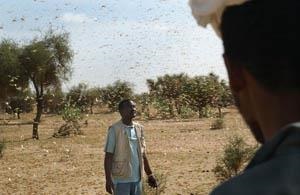Niger and Mali work to contain the Desert Locust threat
17 July 2012, Rome - The Desert Locust threat to pastures and croplands in Niger and Mali is growing after swarms of the insects arrived in the north of the two countries last month from Algeria and Libya.
Locust infestations were first reported in southwest Libya near Ghat in January 2012 and in southeast Algeria.
In late March, FAO warned that swarms could arrive in Niger and Mali by June. Continued rains and the resulting growth of vegetation led to the formation of swarms by mid-May. Survey and control operations were hampered by insecurity along both sides of the border in Algeria and Libya. Consequently, the groups and swarms that could not be controlled migrated across the Sahara to Mali and Niger.
During the last three weeks, heavy rains fell in northern Mali and Niger, allowing the maturation of the Desert Locust adults that are now laying eggs in those areas. Hatching has started and will continue this month, causing locust numbers to increase further.
Seasonal rains are expected to be normal in the Sahel and northern Sahel this summer where the locust infestations are currently present.
"Rains have already fallen in northern Niger and Mali. This will provide good breeding conditions and the possibility for a second generation in which large numbers of locusts could arise at the end of the summer," said Keith Cressman, FAO Senior Locust Forecasting Officer. "At that time, swarms could move to Mauritania, Algeria, Libya and even southern Morocco as well as threaten crops during the harvest period in the Sahel of West Africa."
Ground teams mobilized in Niger have treated 1,200 hectares against the pest since 5 June. However, in northern Mali control operations cannot be carried out because of political conflict and survey efforts must rely on an informal information network of local inhabitants and nomads. Locusts have also been seen in eastern Chad and in Darfur in western Sudan.
In neighbouring countries, survey teams have been deployed earlier than usual in southern Mauritania and are being organized in Chad. National action plans for Desert Locust operations have been developed in Mali, Niger and Chad in accordance with the national contingency plans.
The Organization has informed its member countries of the Desert Locust threat and an action plan for the current two months was prepared during the recent session of the Desert Locust Control Committee. This plan states among other things that there is no need to purchase pesticides to spray the locusts because stocks in nearby countries can be used. WFP has agreed to assist in airlifting these stocks to affected countries.
In addition to efforts made by the affected countries, FAO has
appealed for $10 million to maintain and expand operations. So far, France has pledged €850,000 and discussions are ongoing with four other donors for another $4 million. An additional $2.8 million of emergency funding has been pledged by donors bilaterally at the country level to address the current threat.
Although Niger, Mali and other Sahelian countries have trained locust survey and control teams, funding is needed in an emergency to expand their capacity to respond on a large scale and for logistical support such as vehicles, communication equipment and pesticide delivery. Lack of equipment is particularly acute in Mali, where more than 30 pickup trucks and other locust equipment were looted recently in the northern part of the country.
